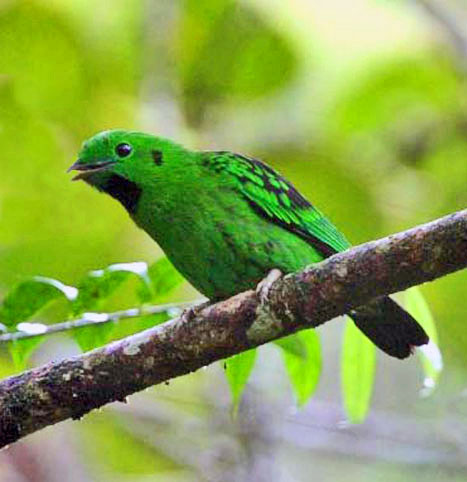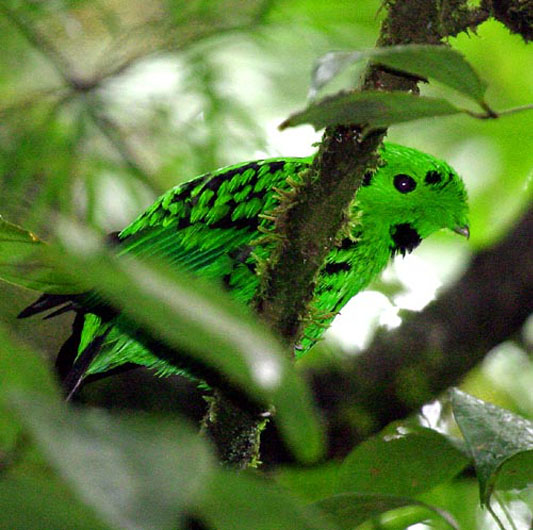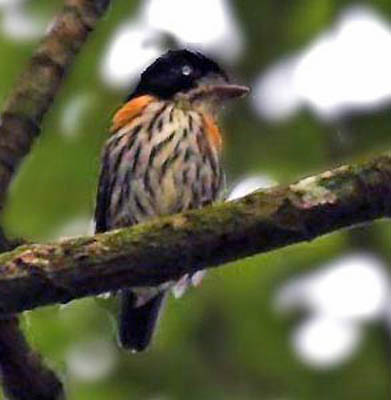| |
CALYPTOMENID BROADBILLS Calyptomenidae
African & Green Broadbills
|
- 6 species in tropical African and Asia
- DR personal total: 4 species (67%), 1 photo'd
|
 Broadbills are spectacular birds but most are exceptionally difficult to observe. This combination makes them one my favorite bird families. A tropical day with a broadbill is an great day. But wait! Recent molecular studies found that two major lineages of broadbills diverged from each other about 55 million years ago (Moyle et al. 2006). After that, the Asities of Madagascar and the Sapayoa of the New World diverged from this group. To maintain Asities as an endemic family in Madagascar, one must now split the Broadbills into two families: the Calyptomenid Broadbills and the Eurylaimid Broadbills (more on this below). Broadbills are spectacular birds but most are exceptionally difficult to observe. This combination makes them one my favorite bird families. A tropical day with a broadbill is an great day. But wait! Recent molecular studies found that two major lineages of broadbills diverged from each other about 55 million years ago (Moyle et al. 2006). After that, the Asities of Madagascar and the Sapayoa of the New World diverged from this group. To maintain Asities as an endemic family in Madagascar, one must now split the Broadbills into two families: the Calyptomenid Broadbills and the Eurylaimid Broadbills (more on this below).
The Calyptomenid Broadbills are just 6 species: three green broadbills in Asia and three lowland forest broadbills in Africa. These are all great birds but for different reasons. The three green broadbills are truly gorgeous and the largest and perhaps the most impressive is Whitehead's Broadbill, an endemic of montane Borneo (left, a lovely shot by Hideo Tani).
The three African broadbills are rather plain in comparison, but they make up for it in behavior. African Broadbill (below) sits quietly high above the ground, just under the canopy, and darts out after prey with incredibly sharp snaps of its huge broad bills. You look up and, if lucky, see the small, stocky, big-billed bird above you. More impressive is the display flight of both sexes: the display produces a very loud, very fast trilling buzz, made by vibrating outer primaries, audible to 60m (60 yards) away, that slows, accelerates and then abruptly stops, transcribed as “ttttt-rrrrrrrrrrrrrrrup!” It is a sound unlike anything else in the African forest. |
 |
 The velvet greens of Whitehead's Broadbill in the Bornean cloud forest (left, in an excellent shot by Gareth Knass) are as neon-bright as the crimson-red of the male Andean Cock-of-the-Rock is in the Andean rainforest. Indeed, with its small bill and puffed-out forehead, this broadbill might pass an the Asian version of cock-of-the-rock. On top of that it has an amazing vocalizing of cackles and raucous cries. It was those calls that permitted Rita and me to finally see one on Mt. Kinabalu. In addition to its incredible selection of raucous calls, the male had an elaborate bowing and peering behavior. The velvet greens of Whitehead's Broadbill in the Bornean cloud forest (left, in an excellent shot by Gareth Knass) are as neon-bright as the crimson-red of the male Andean Cock-of-the-Rock is in the Andean rainforest. Indeed, with its small bill and puffed-out forehead, this broadbill might pass an the Asian version of cock-of-the-rock. On top of that it has an amazing vocalizing of cackles and raucous cries. It was those calls that permitted Rita and me to finally see one on Mt. Kinabalu. In addition to its incredible selection of raucous calls, the male had an elaborate bowing and peering behavior.
There is another spectacular Bornean endemics: Hose's Broadbill Calyptomena hosii. So far we've been unable to locate any in the wild, but I eventually held a specimen at a major museum. The glistening colors — including a rich blue belly — explained the old name for Hose's: the "Magnificent Green Broadbill"! Long ago I chose it (and Whitehead's Broadbill) as among the "top 50 birds of the world." Back then (1970s) I could not find any painting of it at all, so I made my own from a handbook description (below).
 |
The two Bornean endemics, plus Green Broadbill Calyptomena viridis which also occurs on the mainland of southeast Asia, are primarily fruit eaters. They build elaborate, hanging, purse-shaped nests. In these Calyptomenid Broadbills, the nests are suspended close to the branch and the entrance is at the top. In this they differ from Eurylaimid Broadbills (and Asities and Sapayoa) whose nest is suspended farther from the branch, and the entrance is at the side (Prum 1993, Moyle et al. 2006).
 The most surprising result of the new molecular evidence of relationships and evolution in the broadbills (based on nuclear DNA; Moyle et al. 2006), is that there were multiple dispersals of early broadbills to Africa and the New World. It appears that for a short time (10 million years) the Eurylaimides evolved in isolation on India in the Indian Ocean, before India smashed into Eurasia. Northeast India made contact with the Asian continent by the Paleocene, during the warmest time in the Tertiary (crocodiles and flying lemurs north to Ellesmere Island, 78 degrees N latitude!). The most surprising result of the new molecular evidence of relationships and evolution in the broadbills (based on nuclear DNA; Moyle et al. 2006), is that there were multiple dispersals of early broadbills to Africa and the New World. It appears that for a short time (10 million years) the Eurylaimides evolved in isolation on India in the Indian Ocean, before India smashed into Eurasia. Northeast India made contact with the Asian continent by the Paleocene, during the warmest time in the Tertiary (crocodiles and flying lemurs north to Ellesmere Island, 78 degrees N latitude!).
The Calyptomenid Broadbills dispersed east (to southeast Asia) and west (to Africa) during this time. Presumably, over time, many intermediate species became extinct with changing climate, leaving today's three green broadbills in southeast Asia, and three species isolated in the lowlands of central Africa. Several million years later the Sapayoa diverged in the New World tropics, the Asities diverged in Madagascar, and Grauer's Broadbill Pseudocalyptomena graueri diverged from the remaining Eurylaimid Broadbills that still exist today from Indian to southeast Asia.
Today's three African species of Calyptomenid Broadbills [genus Smithornis] lack the dazzling colors of Asian family members, but their behaviors are special. The central African specialty is Rufous-sided Broadbill (right, another Gareth Knass photo). I've seen this species at M'Passa Reserve in northeastern Gabon, in the heart of the Congo Basin rainforest. When finally located, the tiny broadbill seemed to be "all bill" and nothing else except for a rusty wash at the shoulder. The final member is Gray-headed Broadbill Smithornis sharpei, residing from Nigeria to Gabon, and on the Gulf of Guinea island of Bioko.
|
| |
Photos: The first photo of Whitehead's Broadbill Calyptomena whiteheadi was taken by Hideo Tani on Mt. Kinabalu, Sabah, Borneo, Malaysia, in April 2004; the photo of Whitehead's Broadbill by Gareth Knass is also from Mt. Kinabulu. The canopy-sitting African Broadbill Smithornis capensis was in the Kakamega Forest, Kenya, in Nov 1981 (and digitized from a slide). Gareth Knass also photographed the Rufous-sided Broadbill Smithornis rufolateralis in central Africa.
All photos © Don Roberson, except those attributed to © Gareth Knass and © Hideo Tani, used with permission; all rights reserved.
Family book: 
Lambert, Frank, and Martin Woodcock. 1996. Pittas, Broadbills, and Asities. Pica Press, Sussex, England.
In the standard format of recent books in the Pica Press series, color plates are found separately (with facing page captions) from the text, giving the feeling this is meant to be a field guide. The quality of the paintings is good, at least to my eye, given my minimal experience in the wild with these great birds but more experience in handling museum specimens. However, not even well-printed plates can capture the glistening colors of these wonderful birds, and the "field guide" poses are stiff and lifeless. The introductory text appears up-to-date, and the species accounts seemed well-researched. I found no obvious errors in the maps or text, but then I know comparatively little about these families. Despite giving the book high marks for apparent accuracy and attractive paintings within the limits of the genre, how I wish for a more "old-fashioned" book on these special families, with full-page spreads of each species in habitat and evocative detail of each species' discovery to science! The "field guide" approach to the art, and the plodding quality of the scientific text, just does not do justice to these marvelous creatures. Yet for what it is, the book is generally well-done and a welcome addition to the bookshelf. Lambert & Woodcock did not anticipate the actual relationships shown by the nuclear DNA research (Moyle et al. 2006), so this fine family book is already outdated on phylogeny and related issues.
The Handbook of the Birds of the World volume that covered this family (Bruce 2003) included, as expected, spectacular photos. However, it, too, did not anticipate the true nature of the relationships among this group.
Literature cited:
Bruce, M. 2003. Family Eurylaimidae (Broadbills), pp. 54–93 in Handbook of the Birds of the World (del Hoyo, J., A. Elliott, & D.A. Christie, eds.).Vol. 8. Lynx Edicions, Barcelona.
Moyle, R.G., R.T. Chesser, R.O. Prum, P. Schikler, and J. Cracraft. 2006. Phylogeny and evolutionary history of Old World suboscine birds (Aves: Eurylaimides). Amer. Mus. Novitates 3544: 1–22.
Prum, R. O. 1993. Phylogeny, biogeography, and evolution of the broadbills (Eurylaimidae) and asities (Philepittidae) based on morphology. Auk 110: 304–324.
Sibley, C.G., and J.E. Ahlquist. 1990. Phylogeny and Classification of Birds: a Study of Molecular Evolution. Yale Univ. Press, New Haven, CT.
|
|
|


 Broadbills are spectacular birds but most are exceptionally difficult to observe. This combination makes them one my favorite bird families. A tropical day with a broadbill is an great day. But wait! Recent molecular studies found that two major lineages of broadbills diverged from each other about 55 million years ago (Moyle et al. 2006). After that, the Asities of Madagascar and the Sapayoa of the New World diverged from this group. To maintain Asities as an endemic family in Madagascar, one must now split the Broadbills into two families: the Calyptomenid Broadbills and the Eurylaimid Broadbills (more on this below).
Broadbills are spectacular birds but most are exceptionally difficult to observe. This combination makes them one my favorite bird families. A tropical day with a broadbill is an great day. But wait! Recent molecular studies found that two major lineages of broadbills diverged from each other about 55 million years ago (Moyle et al. 2006). After that, the Asities of Madagascar and the Sapayoa of the New World diverged from this group. To maintain Asities as an endemic family in Madagascar, one must now split the Broadbills into two families: the Calyptomenid Broadbills and the Eurylaimid Broadbills (more on this below).  The velvet greens of Whitehead's Broadbill in the Bornean cloud forest (left, in an excellent shot by Gareth Knass) are as neon-bright as the crimson-red of the male Andean Cock-of-the-Rock is in the Andean rainforest. Indeed, with its small bill and puffed-out forehead, this broadbill might pass an the Asian version of cock-of-the-rock. On top of that it has an amazing vocalizing of cackles and raucous cries. It was those calls that permitted Rita and me to finally see one on Mt. Kinabalu. In addition to its incredible selection of raucous calls, the male had an elaborate bowing and peering behavior.
The velvet greens of Whitehead's Broadbill in the Bornean cloud forest (left, in an excellent shot by Gareth Knass) are as neon-bright as the crimson-red of the male Andean Cock-of-the-Rock is in the Andean rainforest. Indeed, with its small bill and puffed-out forehead, this broadbill might pass an the Asian version of cock-of-the-rock. On top of that it has an amazing vocalizing of cackles and raucous cries. It was those calls that permitted Rita and me to finally see one on Mt. Kinabalu. In addition to its incredible selection of raucous calls, the male had an elaborate bowing and peering behavior. 
 The most surprising result of the new molecular evidence of relationships and evolution in the broadbills (based on nuclear DNA; Moyle et al. 2006), is that there were multiple dispersals of early broadbills to Africa and the New World. It appears that for a short time (10 million years) the Eurylaimides evolved in isolation on India in the Indian Ocean, before India smashed into Eurasia. Northeast India made contact with the Asian continent by the Paleocene, during the warmest time in the Tertiary (crocodiles and flying lemurs north to Ellesmere Island, 78 degrees N latitude!).
The most surprising result of the new molecular evidence of relationships and evolution in the broadbills (based on nuclear DNA; Moyle et al. 2006), is that there were multiple dispersals of early broadbills to Africa and the New World. It appears that for a short time (10 million years) the Eurylaimides evolved in isolation on India in the Indian Ocean, before India smashed into Eurasia. Northeast India made contact with the Asian continent by the Paleocene, during the warmest time in the Tertiary (crocodiles and flying lemurs north to Ellesmere Island, 78 degrees N latitude!). 